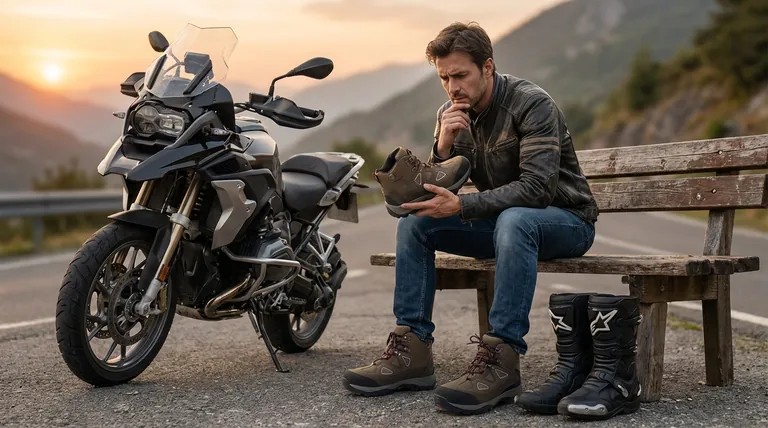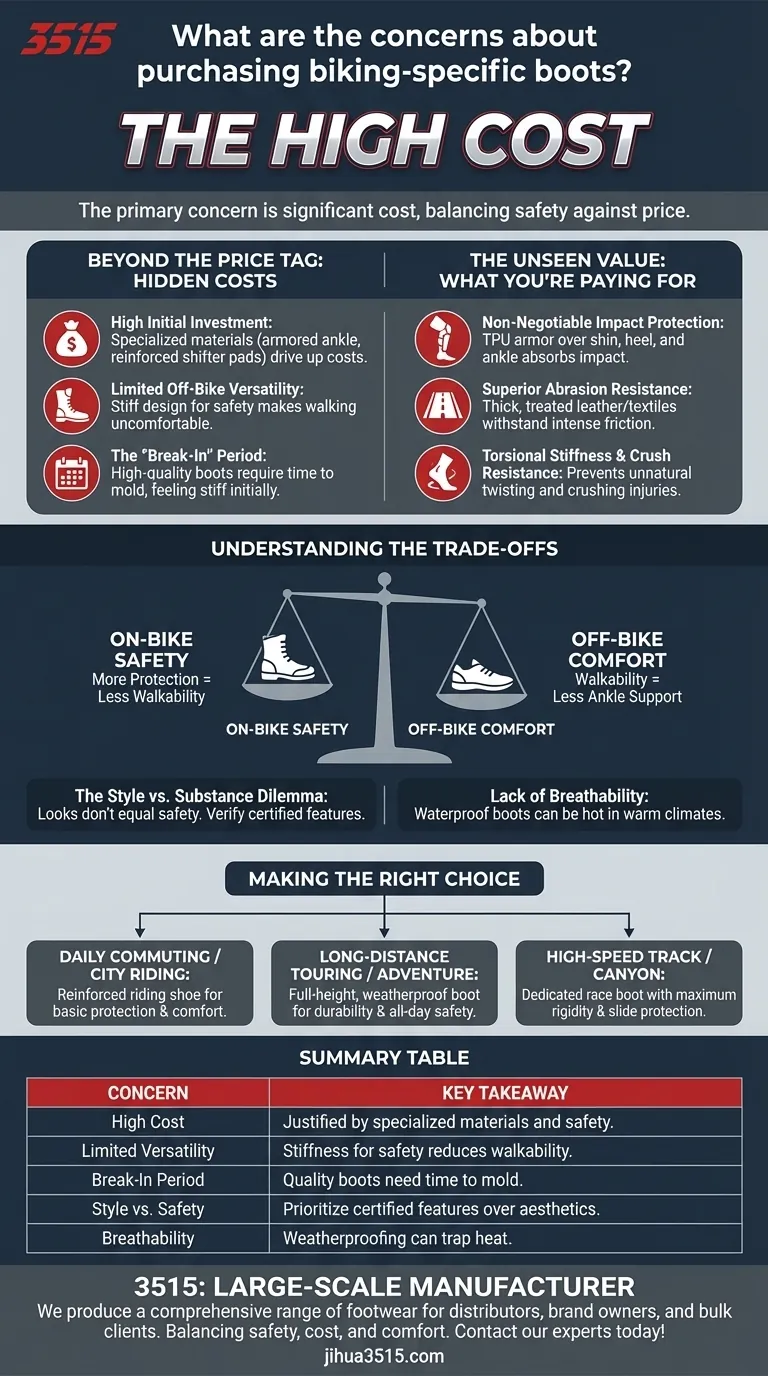The primary concern when purchasing biking-specific boots is their significant cost. This high price tag often makes riders hesitant, forcing them to weigh whether the specialized protective features and materials truly justify the investment over more conventional and affordable footwear.
While the sticker shock of motorcycle boots is a valid and immediate concern, the deeper issue is a trade-off between single-purpose safety and everyday versatility. The real question is not just about cost, but about what level of protection your riding demands.

Beyond the Price Tag: The Hidden Costs
The most obvious concern is the initial financial outlay. However, other non-monetary costs and inconveniences factor into the decision.
The High Initial Investment
Dedicated motorcycle boots are engineered with specialized materials and construction methods. Features like armored ankle protection, reinforced shifter pads, and abrasion-resistant leather or textiles significantly drive up manufacturing costs compared to standard boots.
Limited Off-Bike Versatility
Most true riding boots are stiff by design to protect your ankles from torsion and impact. This essential safety feature makes them rigid, heavy, and often uncomfortable for walking any significant distance, limiting their use to time spent on the bike.
The "Break-In" Period
Many high-quality leather or composite boots require a substantial break-in period. During this time, they can feel overly stiff and restrictive, which can be a frustrating experience before they mold to your feet.
The Unseen Value: What You're Paying For
Understanding why these boots are expensive requires looking at them as critical safety equipment rather than simple footwear.
Non-Negotiable Impact Protection
In a crash, your feet and ankles are extremely vulnerable. Motorcycle boots incorporate armor, often made of thermoplastic polyurethane (TPU), over the shin, heel, and ankle bones to absorb and distribute impact forces that would easily shatter bones.
Superior Abrasion Resistance
Standard shoes or hiking boots can be shredded in seconds when sliding on asphalt. Riding boots use thick, treated leather or advanced synthetic fabrics specifically designed to withstand this intense friction, protecting your skin from severe road rash.
Torsional Stiffness and Crush Resistance
This is a critical feature often overlooked. Riding boots are built to prevent your ankle from twisting unnaturally or being crushed under the weight of the bike. Their rigid structure is the primary defense against debilitating, long-term injuries.
Understanding the Trade-offs
Choosing the right footwear means being honest about the compromises between absolute protection and practical usability.
Sacrificing Walkability for On-Bike Safety
The core trade-off is simple: the more protective a boot is, the less comfortable it will be for walking. A track-day race boot offers maximum protection but is nearly impossible to walk in, while a stylish "riding shoe" offers walkability at the cost of crucial ankle support.
The Style vs. Substance Dilemma
Many products are marketed as motorcycle footwear but offer little more protection than a standard work boot. A common pitfall is choosing a boot for its looks without verifying it has essential safety features like a rigid sole, reinforced ankle protection, and a secure closure system that won't fail in a crash.
Lack of Breathability
Heavy-duty, waterproof boots that offer excellent protection from weather and impact can be extremely hot in warm climates. This lack of ventilation can lead to significant discomfort on long summer rides.
Making the Right Choice for Your Goal
Your decision should be based entirely on your primary riding style and risk exposure.
- If your primary focus is daily commuting or casual city riding: Consider a reinforced, over-the-ankle riding shoe that offers basic protection while maximizing off-bike comfort and style.
- If your primary focus is long-distance touring or adventure riding: Invest in a full-height, weatherproof boot with certified protection, as durability and all-day safety are your top priorities.
- If your primary focus is high-speed track or canyon riding: Choose a dedicated race boot with maximum torsional rigidity and slide protection, where off-bike comfort is not a consideration.
Ultimately, viewing a motorcycle boot as essential safety equipment, not just footwear, clarifies its true value and makes the investment decision much simpler.
Summary Table:
| Concern | Key Takeaway |
|---|---|
| High Cost | Justified by specialized materials and safety features like armor and abrasion resistance. |
| Limited Versatility | Stiffness for on-bike safety reduces off-bike comfort and walkability. |
| Break-In Period | High-quality boots require time to mold to your feet for optimal fit. |
| Style vs. Safety | Prioritize certified protection features over aesthetics alone. |
| Breathability | Weatherproofing can lead to heat retention in warm climates. |
As a large-scale manufacturer, 3515 produces a comprehensive range of footwear for distributors, brand owners, and bulk clients. We understand the critical balance between safety, cost, and comfort in motorcycle boots. Our production capabilities encompass all types of protective riding boots and shoes, engineered with the right materials and safety features for every riding style. Let us help you source or develop the perfect footwear solution for your market. Contact our experts today to discuss your needs!
Visual Guide

Related Products
- Safety Footwear Wholesale Manufacturer for Custom OEM/ODM Production
- High Performance Fire-Retardant Waterproof Safety Boots
- Premium Flame-Retardant Waterproof Safety Boots and Shoes
- Premium Wholesale Waterproof Safety Boots High Performance Protection for Industrial Markets
- Wholesale Safety Footwear Manufacturer for Bulk & Custom OEM Orders
People Also Ask
- What cultural and environmental considerations are tied to wearing shoes indoors? Balance Hygiene, Tradition, and Foot Health
- What are the cultural perspectives on wearing shoes in the house? A Guide to Home Etiquette & Hygiene
- What do heavy duty boots do? Protect Your Feet in Demanding Work Environments
- How do safety shoes contribute to cost savings for companies? A Strategic Investment in Risk and Cost Management
- What are the differences between steel toe, composite toe, and alloy toe Wellington boots? Choose the Right Safety Toe for Your Job



















